The Claxton farm outside Stradbally in Co Waterford was traditionally a mixed enterprise, with dairy, beef and tillage. However, during the 2000s, Andrew Claxton concentrated more on the beef and tillage side of the business. When his daughter Sarah decided that she wanted to go farming, they took another look at dairy farming.
With a large block of land and quotas on the way out, they felt that they had an opportunity to get back into milk. Margins in the beef and tillage enterprises were a lot lower than in dairy, and if Sarah was going to join the business then overall farm income was going to have to increase.
On the other hand, Andrew’s son David had no interest in farming after leaving school and decided instead to fulfil a childhood dream of becoming a helicopter pilot. Qualifying as an offshore pilot in 2011, he spent the next six years working a helicopter pilot for the oil and gas industry in the North Sea.
When it came to converting the farm to dairy, rather than doing it all themselves, Andrew and Sarah entered into a partnership with Captal Farms in 2012. Captal Farms is the name given to the partnership between Pat Ryan and John Condon – two farmers from Dungarvan and Tallow in Waterford.
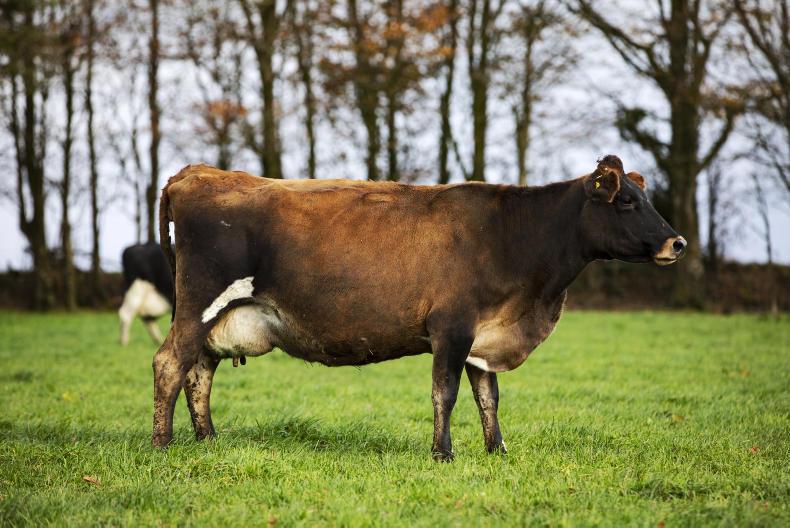
The milking platform in Stradbally extends to 300 acres. \ Donal O'Leary
All the animals for the Claxton farm were derived from Captal Farms. In year one, the Claxtons owned 50% of the herd and Captal owned the other half. The partnership allowed for the Claxtons to buy an increasing share of the herd.
At the same time as the Claxtons were in partnership with Captal, they were also in partnership with their neighbour, Michael Queally. Michael joined the partnership in 2013, bringing 70 acres with him. This partnership continues to this day and Michael plays an active role on the farm.
There were a number of attractions for Andrew and Sarah in entering into a partnership with Captal Farms.
Firstly, they would be getting access to some of the best genetics in the country. Pat Ryan won the EBI competition in 2005 and continues to have one of the best herds in Ireland.
Secondly, by linking up with Pat and John they were getting access to all their skills and knowledge in terms of grassland management, herd health and breeding. There was also the attraction of an expanded network where they could learn from other farmers in the Captal group and get exposure to other farms and ways of doing things.
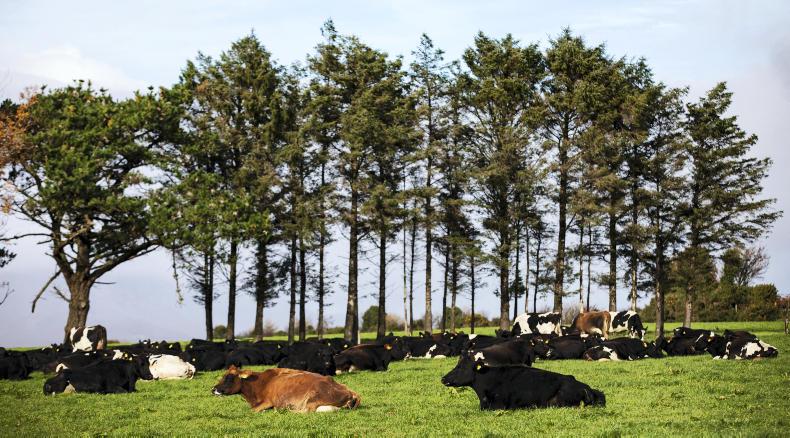
Cow numbers increased from 127 in year one to 400 by year four. \ Donal O'Leary
Testament to the success of the partnership is that cow numbers increased from 127 in year one to 400 by year four. To facilitate the expansion, milk quota was leased from 2012 to 2014.
Fast forward to today and a number of things have changed. To begin with, the partnership between the Claxtons and Captal Farms reached a natural end in 2017 when Captal Farm’s share of the herd was bought out.
At this stage, the milking platform in Stradbally extends to 300 acres and they have 200 acres in outside blocks used for heifer rearing and silage. David returned to the business at the end of 2016 and the 410 cows are managed by all three members of the family.
The farm
Performance on the Claxton farm is excellent. Over the last few years, the herd has produced over 500kg of milk solids per cow from around 500kg of meal. While the amount of meal fed during 2018 will be significantly higher due to the cold and wet spring and dry and hot summer at around 1,000kg per cow, the long-term plan is to keep concentrate feeding at around 500kg/cow.
The herd is spring-calving and very much grass-based. Stocking rate on the milking block is relatively high at 3.4 cows/ha at peak in 2018. With the outside blocks and heifers included, the overall farm is stocked at just under 2.78 livestock units/ha.
The Claxtons have been one of the earlier adapters of lean principles, part of which was influenced by their involvement with Pat Ryan and part of which is due to David’s background in the airline industry. He loves standard operating procedures.

“When I was flying helicopters we had standard operating procedures [SOPs] for everything. Because safety is so important when flying, everything had to be checked and double-checked before we took to the air. There’s no way we could presume that everybody will check the helicopter over in the same way so there was SOPs for every job. I’ve taken this approach home with me and we now have SOPs for milking, calving and calf rearing,” David says.
Sarah explained the milking process. There are always two people milking in the 44-unit GEA herringbone. One milker pre-strips all cows every morning. The other milker attaches the clusters.
“If the person stripping the quarters identifies a cow with mastitis, the first thing they do is put the churn [dump bucket] under the cow so the person putting on clusters knows not to milk that cow. They then go into the dairy and write down the date, cow’s number, the date of last treatment, the antibiotic used, when the cow can go into the tank and any other comments on a large whiteboard. After this, they put red straps on the legs and raddle the udder with red paint too. The cow is milked into the churn and the last thing we do is treat the cow with antibiotics,” Sarah says.
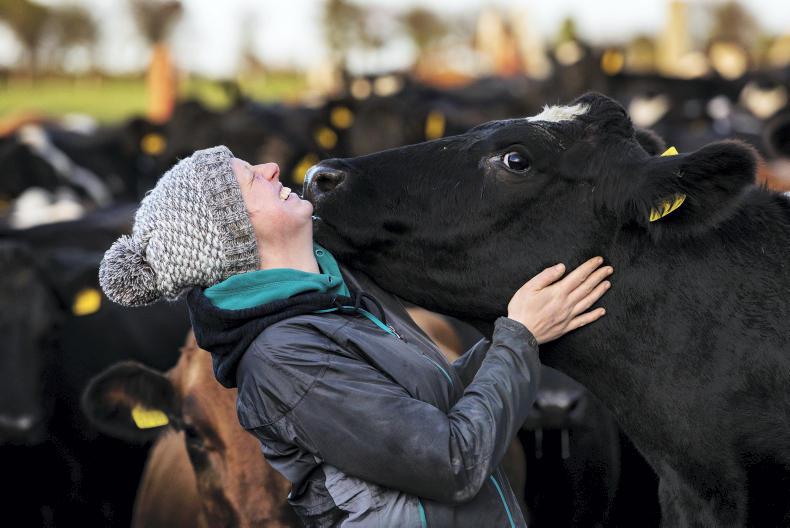
During the week, David does nearly every morning milking and Sarah does nearly every evening milking. \ Donal O'Leary
Leg bands are a key part of the Claxton milking SOP. They use four different coloured leg bands to identify cows. Cows with a yellow leg band are slow milkers and clusters are attached to these cows first. Cows with a red leg band are being treated with antibiotics and their milk is to be dumped. There are cows with a green band on whichever leg has the front quarter dried off. Cows with a blue leg band have the back quarter dried off.
The charts outlining what the different colours represent is hanging up in the dairy and milking parlour and it’s also printed on the milking aprons so it’s easy for the milker to see what colour is for what.
“It’s printed on all of the aprons so everyone wears it. It’s fierce handy. I know myself if you are new to a farm or new to a setup it’s easy to forget what colour represents what. If you’re a bit quiet you might be happy enough to ask the farmer once or twice but you might be shy the third or fourth time and just guess, but that could be an expensive mistake if the wrong quarter is milked. This way, all anyone milking has to do is look at the apron on the person milking with you and then they know. It works great,” David says.
Fifteen more units were added to the parlour at the end of 2017 as milking times were getting too long. With the extra units, the number of rows reduced from 15 to 9.5. The parlour is now a 44-unit herringbone so it takes two people to milk at all times. The parlour has automatic cluster removers and an independent vacuum line for using the dump bucket. The dump bucket has its own set of clusters to reduce the risk of cross infection.

The parlour is now a 44-unit herringbone. \ Donal O'Leary
Andrew says the key to milking properly is to have a good routine. Cows are never washed down prior to milking and shouting at cows or the use of sticks or pinching is prohibited. Milking takes about two hours including wash-up time. There are scissor gates at the front meaning that there is a constant flow of cows into the parlour, with the first cow in place just as the last cow walks out. Andrew says that at certain times of the year, the front gate could be open while there are still 10 cows being milked at the back.
The collecting yard is nearly all covered, but pillars of the sheds make it impossible for a backing gate to be installed. As a result, some meal is fed all year round to encourage cows into the parlour.
Andrew says that when they were expanding the parlour they got extra feed points installed.
“In the original 29-unit parlour we had only one feed point, meaning the whole line were fed at once. Now we have three points, meaning we can feed the cows in batches of 15 or so. Before, you’d have to wait until the row was full before you could feed any cow.”
This winter will be the first time since 2012 that the Claxton cows will have been wintered on cubicles. Up to now, all the cows were wintered on straw bedding. When they got back into cows, the straw-bedded sheds were already in place and straw was cheap and plentiful. Cows were bedded on straw and fed outside in yards with the slurry scraped into tanks. A McHale straw blower was used for bedding.
A big new straw-bedded shed was built in 2016 to accommodate the expanding herd. However, with the price of straw going up and up and the fact that tillage is no longer part of the farm system, the Claxtons decided to convert the sheds to cubicles. A total of 460 cubicles were installed by the Claxtons themselves in autumn 2018.
A builder was employed to do the slurry tanks but the family decided to do the cubicle beds and erect the cubicles and install mats themselves. Extra help was taken on for the farm when the building work was going on.
“It made this back-end very busy. We were just about finished all the extra feeding due to the drought and then we all got stuck into building work. I suppose it’s not ideal but it reduces the building costs by doing it ourselves. We got lots of help though, which made the job that bit easier,” David says.
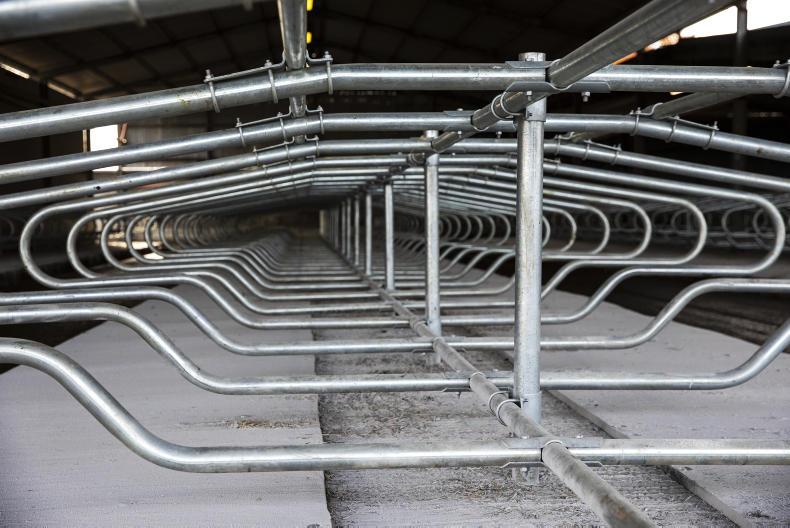
A Bobman has been bought to clean and lime the cubicles. \ Donal O'Leary
Cubicles
The cubicles should also help to reduce the workload on the farm this winter. Previously, the cows had to be fed and bedded every day, but now it will just be a case of feeding and cleaning cubicles. It will definitely reduce the workload and it might also help to make the cow housing cleaner. A Bobman has been bought to clean and lime the cubicles. While the SCC has always been good, at around 90,000 average SCC over the year, the Claxtons do put a big effort into managing SCC with cows stripped daily.
In terms of labour, Andrew, Sarah and David are the only full-time employees. During the week, David does nearly every morning milking and Sarah does nearly every evening milking. They are helped out by Shane and Robert, who do six milkings a week each. David and Sarah’s mother, Jennifer, milks with Andrew at the weekends. Jennifer also looks after calf rearing in spring along with David’s wife Melissa. David Mears is employed in winter and spring for the winter feeding and night calving while their partner in the business, Michael Queally, gives a hand every day, bringing in cows and scraping yards.
The majority of the big machinery jobs, such as slurry and dung spreading and silage harvesting, are done by a contractor.
The milking platform is laid out in one 120ha block with 38 paddocks. Andrew says that the furthest paddock is 1.5km from the yard. On the days they are grazing the furthest paddocks they will sometimes get the cows to do three grazings on the faraway paddock and then one grazing near the yard, to reduce the amount of walking to be done by the herd. They tend to graze the far away paddocks at night so the cows eat more when they are down there.
An automatic drafting gate drafts the older cows so they don’t have to walk to the furthest paddocks and they are kept in a group closer to the yard.

“We try to keep the roadways as good as we can. We don’t want roadways up against hedges because if the sun can’t get on to the road it will never dry out. The other thing we do is to take out obstacles along the road. The golden rule is that if a cow stops on a road, for whatever reason, she will more than likely dirty herself when she starts moving again. When the whole herd does this, there’s a right mess and everything slows down,” Andrew says.
Grass measurement
Grass is measured weekly by Sarah. The total grass growth in 2017 was 15.5t/ha but Sarah reckons it will be back by 4t/ha in 2018. In the long term, they feel that the farm is capable of growing over 16t/ha. The farm is dry and free-draining and soil fertility is pretty good.
The total growth on the farm in 2018 up to the end of October was 11.35t/ha, due to the summer drought and bad spring.
This is the first year that the farm has been using a fertiliser plan for each paddock. It’s a full programme based on soil sample results with extra phosphorus spread in spring and extra potash spread in autumn. David spreads the fertiliser and says that it has worked very well. They felt that despite the drought they had more grass than they expected along with a bigger than normal first cut.
“We’ve never seen the farm to stay green for so long. Even during the drought, the place stayed mostly green and was growing, albeit at a lower rate than normal. Cows are grazing out better this year also,” Sarah says.
With 60 in-calf heifers joining the herd in 2019, the Claxtons will end up milking close to 410 cows again next year (15% replacement rate). Having gone from milking zero cows in 2011 to over 400 cows in 2019 is a fair achievement for Andrew, but to do so while working with and creating a great lifestyle for his family is an even greater achievement. I asked David about why he left the dream job as a helicopter pilot to return to west Waterford.
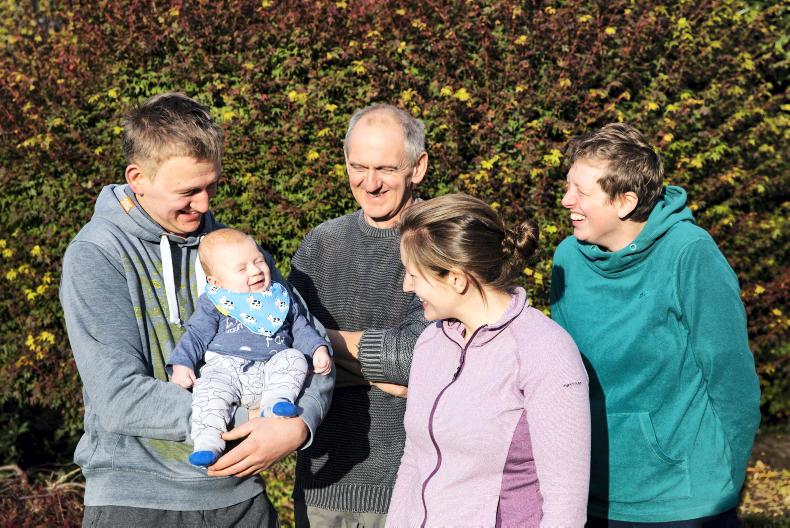
David is married to Melissa and they have a baby boy named Charlie. \ Donal O'Leary
“I wanted to return to Ireland. When I was working I’d be away for six weeks at a time to remote spots, which is tough going. In the meantime, the family farm expanded and there was more going on at home. Farming is more of a business now.
“I’m married to Melissa and we have a baby, Charlie. I’m working with my family and get to live near my home and also close to Melissa’s home. My lifestyle is better now,” David says.
This is one of the most efficient farms I’ve ever been on. Performance is excellent, things are done well, the farm is very profitable and nobody is killing themselves with work. As one of the first farms in Ireland to adopt SOPs and lean principles, the Claxton farm is an example to other large farms.
Andrew and Sarah didn’t have the expertise at the start of the dairy journey in 2012 so they got help from the best by going into partnership with Pat Ryan. Now, Pat Ryan says he is learning from the Claxtons. The lessons I got when driving away from Stradbally: learn from the best, be the best, keep it simple and live the dream.
This article is taken from the Irish Dairy Farmer 2019 annual, which can be bought here.
The Claxton farm outside Stradbally in Co Waterford was traditionally a mixed enterprise, with dairy, beef and tillage. However, during the 2000s, Andrew Claxton concentrated more on the beef and tillage side of the business. When his daughter Sarah decided that she wanted to go farming, they took another look at dairy farming.
With a large block of land and quotas on the way out, they felt that they had an opportunity to get back into milk. Margins in the beef and tillage enterprises were a lot lower than in dairy, and if Sarah was going to join the business then overall farm income was going to have to increase.
On the other hand, Andrew’s son David had no interest in farming after leaving school and decided instead to fulfil a childhood dream of becoming a helicopter pilot. Qualifying as an offshore pilot in 2011, he spent the next six years working a helicopter pilot for the oil and gas industry in the North Sea.
When it came to converting the farm to dairy, rather than doing it all themselves, Andrew and Sarah entered into a partnership with Captal Farms in 2012. Captal Farms is the name given to the partnership between Pat Ryan and John Condon – two farmers from Dungarvan and Tallow in Waterford.

The milking platform in Stradbally extends to 300 acres. \ Donal O'Leary
All the animals for the Claxton farm were derived from Captal Farms. In year one, the Claxtons owned 50% of the herd and Captal owned the other half. The partnership allowed for the Claxtons to buy an increasing share of the herd.
At the same time as the Claxtons were in partnership with Captal, they were also in partnership with their neighbour, Michael Queally. Michael joined the partnership in 2013, bringing 70 acres with him. This partnership continues to this day and Michael plays an active role on the farm.
There were a number of attractions for Andrew and Sarah in entering into a partnership with Captal Farms.
Firstly, they would be getting access to some of the best genetics in the country. Pat Ryan won the EBI competition in 2005 and continues to have one of the best herds in Ireland.
Secondly, by linking up with Pat and John they were getting access to all their skills and knowledge in terms of grassland management, herd health and breeding. There was also the attraction of an expanded network where they could learn from other farmers in the Captal group and get exposure to other farms and ways of doing things.

Cow numbers increased from 127 in year one to 400 by year four. \ Donal O'Leary
Testament to the success of the partnership is that cow numbers increased from 127 in year one to 400 by year four. To facilitate the expansion, milk quota was leased from 2012 to 2014.
Fast forward to today and a number of things have changed. To begin with, the partnership between the Claxtons and Captal Farms reached a natural end in 2017 when Captal Farm’s share of the herd was bought out.
At this stage, the milking platform in Stradbally extends to 300 acres and they have 200 acres in outside blocks used for heifer rearing and silage. David returned to the business at the end of 2016 and the 410 cows are managed by all three members of the family.
The farm
Performance on the Claxton farm is excellent. Over the last few years, the herd has produced over 500kg of milk solids per cow from around 500kg of meal. While the amount of meal fed during 2018 will be significantly higher due to the cold and wet spring and dry and hot summer at around 1,000kg per cow, the long-term plan is to keep concentrate feeding at around 500kg/cow.
The herd is spring-calving and very much grass-based. Stocking rate on the milking block is relatively high at 3.4 cows/ha at peak in 2018. With the outside blocks and heifers included, the overall farm is stocked at just under 2.78 livestock units/ha.
The Claxtons have been one of the earlier adapters of lean principles, part of which was influenced by their involvement with Pat Ryan and part of which is due to David’s background in the airline industry. He loves standard operating procedures.

“When I was flying helicopters we had standard operating procedures [SOPs] for everything. Because safety is so important when flying, everything had to be checked and double-checked before we took to the air. There’s no way we could presume that everybody will check the helicopter over in the same way so there was SOPs for every job. I’ve taken this approach home with me and we now have SOPs for milking, calving and calf rearing,” David says.
Sarah explained the milking process. There are always two people milking in the 44-unit GEA herringbone. One milker pre-strips all cows every morning. The other milker attaches the clusters.
“If the person stripping the quarters identifies a cow with mastitis, the first thing they do is put the churn [dump bucket] under the cow so the person putting on clusters knows not to milk that cow. They then go into the dairy and write down the date, cow’s number, the date of last treatment, the antibiotic used, when the cow can go into the tank and any other comments on a large whiteboard. After this, they put red straps on the legs and raddle the udder with red paint too. The cow is milked into the churn and the last thing we do is treat the cow with antibiotics,” Sarah says.

During the week, David does nearly every morning milking and Sarah does nearly every evening milking. \ Donal O'Leary
Leg bands are a key part of the Claxton milking SOP. They use four different coloured leg bands to identify cows. Cows with a yellow leg band are slow milkers and clusters are attached to these cows first. Cows with a red leg band are being treated with antibiotics and their milk is to be dumped. There are cows with a green band on whichever leg has the front quarter dried off. Cows with a blue leg band have the back quarter dried off.
The charts outlining what the different colours represent is hanging up in the dairy and milking parlour and it’s also printed on the milking aprons so it’s easy for the milker to see what colour is for what.
“It’s printed on all of the aprons so everyone wears it. It’s fierce handy. I know myself if you are new to a farm or new to a setup it’s easy to forget what colour represents what. If you’re a bit quiet you might be happy enough to ask the farmer once or twice but you might be shy the third or fourth time and just guess, but that could be an expensive mistake if the wrong quarter is milked. This way, all anyone milking has to do is look at the apron on the person milking with you and then they know. It works great,” David says.
Fifteen more units were added to the parlour at the end of 2017 as milking times were getting too long. With the extra units, the number of rows reduced from 15 to 9.5. The parlour is now a 44-unit herringbone so it takes two people to milk at all times. The parlour has automatic cluster removers and an independent vacuum line for using the dump bucket. The dump bucket has its own set of clusters to reduce the risk of cross infection.

The parlour is now a 44-unit herringbone. \ Donal O'Leary
Andrew says the key to milking properly is to have a good routine. Cows are never washed down prior to milking and shouting at cows or the use of sticks or pinching is prohibited. Milking takes about two hours including wash-up time. There are scissor gates at the front meaning that there is a constant flow of cows into the parlour, with the first cow in place just as the last cow walks out. Andrew says that at certain times of the year, the front gate could be open while there are still 10 cows being milked at the back.
The collecting yard is nearly all covered, but pillars of the sheds make it impossible for a backing gate to be installed. As a result, some meal is fed all year round to encourage cows into the parlour.
Andrew says that when they were expanding the parlour they got extra feed points installed.
“In the original 29-unit parlour we had only one feed point, meaning the whole line were fed at once. Now we have three points, meaning we can feed the cows in batches of 15 or so. Before, you’d have to wait until the row was full before you could feed any cow.”
This winter will be the first time since 2012 that the Claxton cows will have been wintered on cubicles. Up to now, all the cows were wintered on straw bedding. When they got back into cows, the straw-bedded sheds were already in place and straw was cheap and plentiful. Cows were bedded on straw and fed outside in yards with the slurry scraped into tanks. A McHale straw blower was used for bedding.
A big new straw-bedded shed was built in 2016 to accommodate the expanding herd. However, with the price of straw going up and up and the fact that tillage is no longer part of the farm system, the Claxtons decided to convert the sheds to cubicles. A total of 460 cubicles were installed by the Claxtons themselves in autumn 2018.
A builder was employed to do the slurry tanks but the family decided to do the cubicle beds and erect the cubicles and install mats themselves. Extra help was taken on for the farm when the building work was going on.
“It made this back-end very busy. We were just about finished all the extra feeding due to the drought and then we all got stuck into building work. I suppose it’s not ideal but it reduces the building costs by doing it ourselves. We got lots of help though, which made the job that bit easier,” David says.

A Bobman has been bought to clean and lime the cubicles. \ Donal O'Leary
Cubicles
The cubicles should also help to reduce the workload on the farm this winter. Previously, the cows had to be fed and bedded every day, but now it will just be a case of feeding and cleaning cubicles. It will definitely reduce the workload and it might also help to make the cow housing cleaner. A Bobman has been bought to clean and lime the cubicles. While the SCC has always been good, at around 90,000 average SCC over the year, the Claxtons do put a big effort into managing SCC with cows stripped daily.
In terms of labour, Andrew, Sarah and David are the only full-time employees. During the week, David does nearly every morning milking and Sarah does nearly every evening milking. They are helped out by Shane and Robert, who do six milkings a week each. David and Sarah’s mother, Jennifer, milks with Andrew at the weekends. Jennifer also looks after calf rearing in spring along with David’s wife Melissa. David Mears is employed in winter and spring for the winter feeding and night calving while their partner in the business, Michael Queally, gives a hand every day, bringing in cows and scraping yards.
The majority of the big machinery jobs, such as slurry and dung spreading and silage harvesting, are done by a contractor.
The milking platform is laid out in one 120ha block with 38 paddocks. Andrew says that the furthest paddock is 1.5km from the yard. On the days they are grazing the furthest paddocks they will sometimes get the cows to do three grazings on the faraway paddock and then one grazing near the yard, to reduce the amount of walking to be done by the herd. They tend to graze the far away paddocks at night so the cows eat more when they are down there.
An automatic drafting gate drafts the older cows so they don’t have to walk to the furthest paddocks and they are kept in a group closer to the yard.

“We try to keep the roadways as good as we can. We don’t want roadways up against hedges because if the sun can’t get on to the road it will never dry out. The other thing we do is to take out obstacles along the road. The golden rule is that if a cow stops on a road, for whatever reason, she will more than likely dirty herself when she starts moving again. When the whole herd does this, there’s a right mess and everything slows down,” Andrew says.
Grass measurement
Grass is measured weekly by Sarah. The total grass growth in 2017 was 15.5t/ha but Sarah reckons it will be back by 4t/ha in 2018. In the long term, they feel that the farm is capable of growing over 16t/ha. The farm is dry and free-draining and soil fertility is pretty good.
The total growth on the farm in 2018 up to the end of October was 11.35t/ha, due to the summer drought and bad spring.
This is the first year that the farm has been using a fertiliser plan for each paddock. It’s a full programme based on soil sample results with extra phosphorus spread in spring and extra potash spread in autumn. David spreads the fertiliser and says that it has worked very well. They felt that despite the drought they had more grass than they expected along with a bigger than normal first cut.
“We’ve never seen the farm to stay green for so long. Even during the drought, the place stayed mostly green and was growing, albeit at a lower rate than normal. Cows are grazing out better this year also,” Sarah says.
With 60 in-calf heifers joining the herd in 2019, the Claxtons will end up milking close to 410 cows again next year (15% replacement rate). Having gone from milking zero cows in 2011 to over 400 cows in 2019 is a fair achievement for Andrew, but to do so while working with and creating a great lifestyle for his family is an even greater achievement. I asked David about why he left the dream job as a helicopter pilot to return to west Waterford.

David is married to Melissa and they have a baby boy named Charlie. \ Donal O'Leary
“I wanted to return to Ireland. When I was working I’d be away for six weeks at a time to remote spots, which is tough going. In the meantime, the family farm expanded and there was more going on at home. Farming is more of a business now.
“I’m married to Melissa and we have a baby, Charlie. I’m working with my family and get to live near my home and also close to Melissa’s home. My lifestyle is better now,” David says.
This is one of the most efficient farms I’ve ever been on. Performance is excellent, things are done well, the farm is very profitable and nobody is killing themselves with work. As one of the first farms in Ireland to adopt SOPs and lean principles, the Claxton farm is an example to other large farms.
Andrew and Sarah didn’t have the expertise at the start of the dairy journey in 2012 so they got help from the best by going into partnership with Pat Ryan. Now, Pat Ryan says he is learning from the Claxtons. The lessons I got when driving away from Stradbally: learn from the best, be the best, keep it simple and live the dream.
This article is taken from the Irish Dairy Farmer 2019 annual, which can be bought here. 


















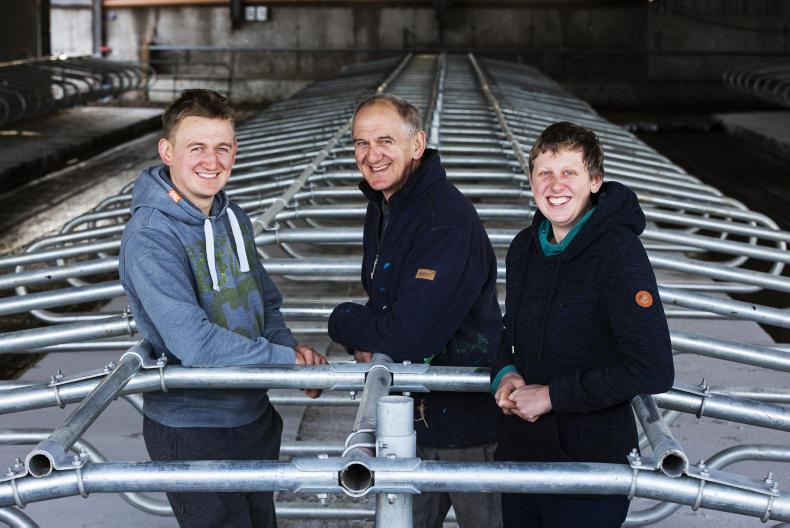


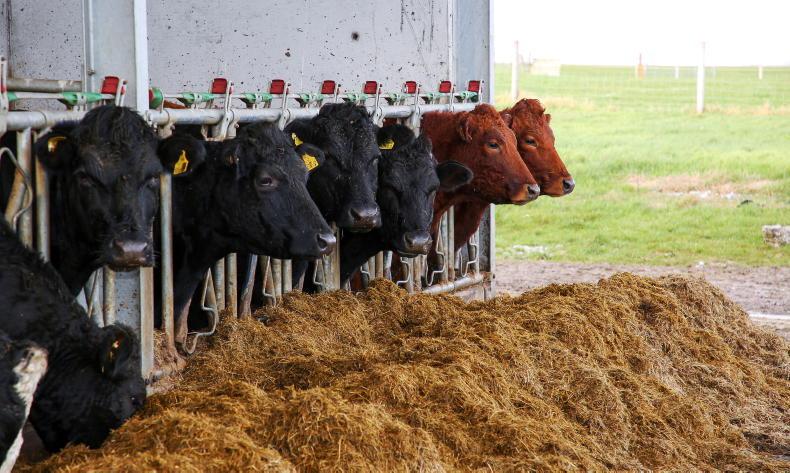
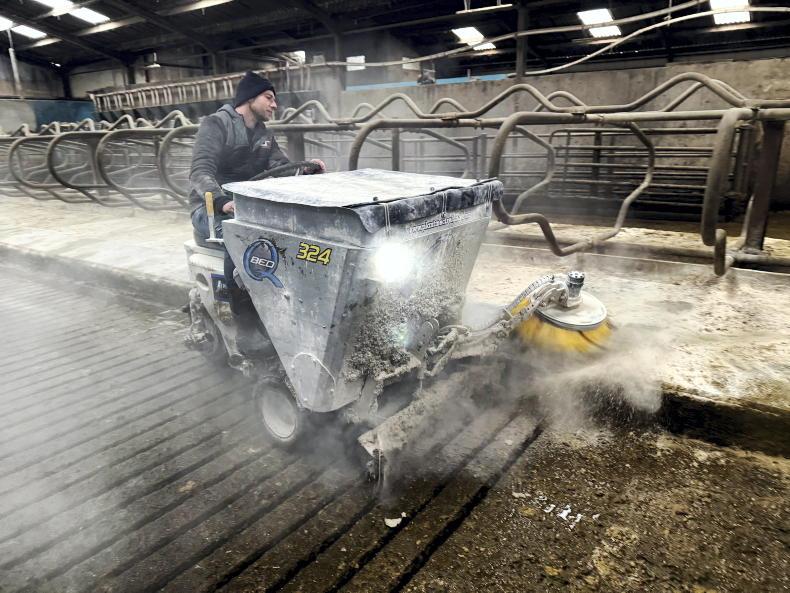
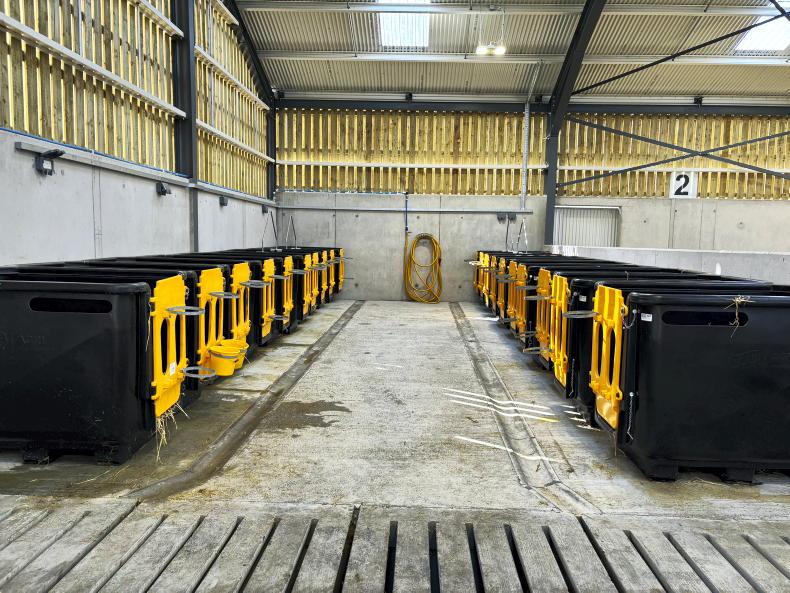
SHARING OPTIONS